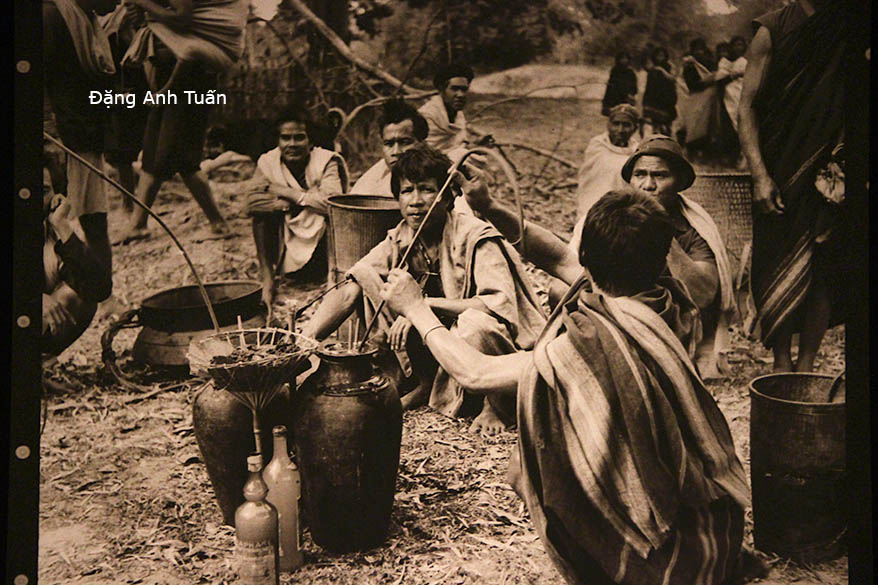Cũng như ông Henri Oger với các bộ sưu tập tranh mộc bản, ông Jean Marie Duchange rất yêu chuộng người dân Việt nhất là đồng bào thiểu số ở Tây Nguyên. Trong ba năm ông làm ở vụ y tế ở miền núi, ông không ngần ngại gian nan những lúc rãnh rỗi cưỡi voi, đi bộ, dùng thuyền đôc mộc hay xe jeep đến các vùng núi để chụp các ảnh nầy với máy ảnh reflex 6×6 bi objectif. Nhưng cuối cùng ông cũng không thực hiện được ý định xuất hành cuốn album vì ông ra đi ở tuổi 88. Dự định in ấn cũng đành hoãn lại. Tuy nhiên để tưởng nhớ và thực hiện hoài bão của ông, con gái ông Evelyne Duchange và cháu ngọai Nadège Bourgoin cống hiến cho hai bảo tàng, một ở Paris là Quai Branly (Paris) và hai là bảo tàng dân tộc học ở Hànội các tác phẩm ảnh của ông bằng négatif. Nhờ vậy mới có dịp chụp lại được ở bảo tàng dân tộc học các ảnh nầy để cùng chung khám phá các tập tục nghi lễ trong những năm 50 của thế kỳ 20. Các tác phẩm ảnh nầy là một nhân chứng vô giá của ông về cuộc sống linh động hằng ngày của các đồng bào thiểu số mà nay không còn thấy nửa ở Tây Nguyên.
Analogue à Henri Oger avec ses estampes en bois, Jean Marie Duchange avait de l’estime pour le peuple vietnamien, en particulier pour les ethnies des Hauts Plateaux du Centre. Profitant des trois années passées à la direction de santé publique des populations montagnardes du Sud Indochinois, il n’hésita pas à parcourir les régions montagneuses à dos d’éléphant, en jeep , en pirogue ou encore à pieds avec difficultés pour réaliser ces photos avec son appareil reflex 6×6 bi objectif quand il avait du temps libre. Mais à la fin, il n’arriva pas à accomplir son rêve de réaliser un album car il fut décédé à l’âge de 88 ans. Son projet d’édition fut abandonné aussi. Pour honorer sa mémoire et pour perpétuer le beau travail d’un passionné de la photographie, sa fille Evelyne Duchange et sa petite fille Nadège Bourgoin ont décidé de faire le don de ses négatifs aux deux musées, l’un à Paris au musée Quai Branly et l’autre à Hànoi, au musée d’ethnologie. Grâce à ce don, j’ai eu l’occasion de passer une journée à ce dernier musée pour faire ces photos et pour nous permettre de découvrir ensemble toutes les coutumes et les traditions dans les années 50 du XXème siècle. Ces photos constituent son témoignage inestimable sur la vie journalière des ethnies qu’il est impossible de retrouver aujourd’hui aux Hauts Plateaux du Centre.
Similar to Henri Oger with his woodblock prints, Jean Marie Duchange held esteem for the Vietnamese people, particularly for the ethnic groups of the Central Highlands. Taking advantage of the three years he spent directing public health for the mountain populations of South Indochina, he did not hesitate to travel through the mountainous regions on elephant back, by jeep, by pirogue, or even on foot with difficulty to take these photos with his 6×6 twin-lens reflex camera whenever he had free time. But in the end, he was unable to fulfill his dream of creating an album as he passed away at the age of 88. His publishing project was also abandoned.
To honor his memory and to perpetuate the beautiful work of a photography enthusiast, his daughter Evelyne Duchange and his granddaughter Nadège Bourgoin decided to donate his negatives to two museums, one in Paris at the Quai Branly Museum and the other in Hanoi at the Museum of Ethnology. Thanks to this donation, I had the opportunity to spend a day at the latter museum to take these photos and to allow us to discover together all the customs and traditions of the 1950s. These photos constitute his invaluable testimony on the daily life of the ethnic groups that can no longer be found today in the Central Highlands

